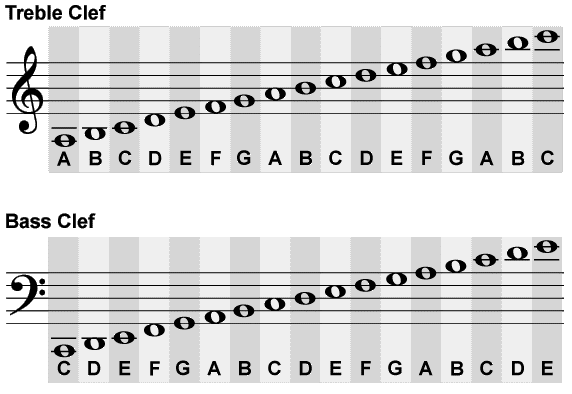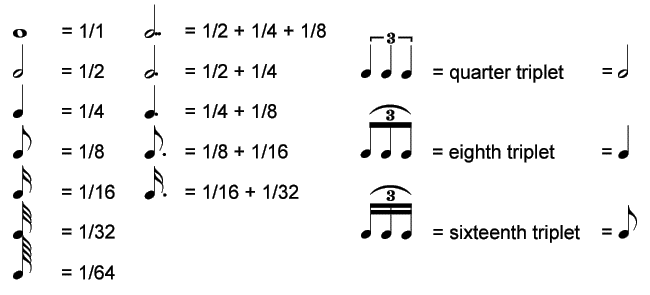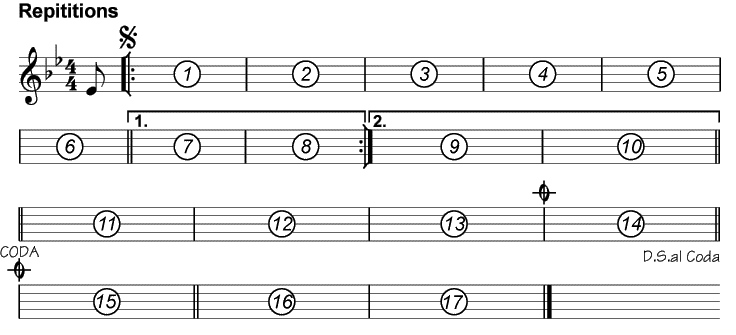

![[Previous Page]](prev.gif)
![[Next Page]](next_dis.gif)
![[Up]](up.gif)
![[Home Page]](home.gif)
![[Mail]](mail.gif)
![[Contents]](contents.gif)

Finally, it is not possible to learn how to play music without knowing a couple of things about sheet music. That does not necessarily mean playing music from staff lines fluently, but you should be able to "decode" what you find on a paper with some staff lines.
Imagine, you want to play a song, that you nearly know. You know, how it should sound, but what you are playing doesn't exactly sound like the piece, you want to play. But you actually don't exactly know why. In this case, the sheet music, you have received or found somewhere can help you to find out what is wrong. Or you haven't played a piece in a long time and you don't remeber it exactly. In this case, sheet music can help you, too.... if... you know how to decode what you find on the staff lines.
Sure, there is also something like the tabulature notation of music, but the information in a pure tab line is pretty limited... in many cases, not even the rythm is described exactly. In many cases, tabulature comes in a combination with the normal staff line notation. The staff line notation cannot fully describe the music, the exact expression cannot be written down, but it is possible to indicate, which notes are emphasized, a decreasing or increasing volume, up and down picks, apreggio etc. pp. and it is sure possible to write down the pitch and duration of a tone.
The Pitch
This is what we want to discuss first. The staff line consists of 5 lines and the "dots" on it are usually no fly shit, but represent the notes. The higher the dot on that ladder, the higher the pitch of that note. Which note it is also depends on squiggle at the very left of the staff line - a staff line is read from left to right, of course. That is called a clef. There are two most common clefs. That is the treble clef and the bass clef. There are sure some other clefs like the alto clef and the tenor clef, but we usually never see those clefs, so I will not talk about them here.

Here you see the treble and the bass clef on a staff line and the pitches that result from the clef. To learn to recognize the pitch on a staff line reqires to remeber one or more reference points on them.
The reference point for the treble clef is the middle line. This marks the B. It is also useful to remeber the notes one leger line below and above the staff line. The first represents a C the latter the A. When you are advancing in reading music, you will have more than those few reference points, of course, but in the beginning, it can help you to start your counting up or down from that reference points.
The reference point of the bass clef is the F, it is the line between the two dots of that clef. Actually,m you can also pick the D, because it is the middle line. My personal preference is the F, though.
The two types of staff lines sure have a certain relation to each other. The treble clef marks a staff line with notes that are higher than the bass clef line (kinda logic, right?). The pivot is the C, that is one leger line above the bass clef line and one leger line below the bass clef line. This is the same pitch.
To note the flats and sharps, some more symbols are required. That are the so called acciedentals. A "b" will transform a not into it's flat note, a "#" will transform a note into it's sharp note.

The accidental is noted before the "dot" (note) it belongs to. The natural will "neutralize" the accidentals that would normaly be valid in that piece or bar. Usually the accidentals that are noted at the beginning of the piece are valid for the whole piece. The accidentals that are noted in front of a note are valid only for one bar. So if a B is played after a Bb (B flat) a natural is required to express that it is a B. In the key of F major, the b of the Bb is noted at the beginning of the piece. So if you want to play a B in a piece that is written in F major, there is also a natural required.
There are also two less often occuring accidentals. That's the double b and the double #. It is used, in case the notation requires it. Imagine that the 9th of a chord is already a Bb and the chord, that should be written down should be a b9 chord. Then the double b is a suitable way to express that. Imagine the 11th of a chord is already a F# and the chord that has to be noted is a #11 chord. Then the double sharp is useful.
 Find the accidentals for the keys here
Find the accidentals for the keys here
Now something that is so important to remember, that I will put a box around it:
| The validity of accidentals The accidentals that are noted at the beginning of a piece and don't belong together with a certain note that is noted directly behind them, are valid for the whole piece. The accidentals that are noted somewhere in a bar and belong together with a certain note, are valid for only that bar. They will influence every note on the same line right of them. After the the line that limits the bar, they will lose their validity. |
Duration
This is the next important thing that can be noted on a staff line. Acually, a note usually has a pitch and a duration. Even the sheet music written for drums have a picthm but in this case, the pitch represents the instrumaent like cymbal or snare durm, bass drum etc.
The kind of symbol used for the note represents the note duration.

The duration of the notes is meassured in beats. What might be a bit confusing is that fact, that a quarter note is one beat long, so a whole note is four beats long. The rest is pretty logic. The half note is two beats long, the eighth note is a half beat long etc.
The basic note durations are noted in the left column of the picture/table above. Note durations like a 1/32 and a 1/64 don't occure very often in guitar music, but you should keep in mind, that there is something like that.
The notes sure can have durations like a quarter plus an eighths etc. This is shown in the middle column. A little dot behind the actual note means that the duration is increased a half of the duration of that actual note. So a quarter with a dot has the duration of a quarter and an eighth together. A dotted eights has the duration of an eighth plus a sixteenth etc. In the top od that column, you will find a half note with two dots. Two dots mean, that the duration of 3/4 od the original duration is added. This doesn't occure very often.
Now we know the "even" note durations, that are built from 1/2, 1/4, 1/8 etc... but there are also some "odd" note durations. The most common are triplets.
Since all easy to read symbols are used up, and since they always occure in groups of three notes, the notation of them is derived from the notation of the "even" notes. An eighth triplet is a group of three eighth, tied together by some kind of bow with a "3" close to that bow.
What might be confusing, that the duration of one of that triplet eighth is not a normal eighth, but three of them foram a quarter note (one beat). So their duration is one third of a beat. Three triplet quarter notes are as long as two beats, thus the duration of a single triplet quarter is two third of a beat.
All triplets work like this. There are some other "odd" note durations, like 5 notes in a group tied together by a bow with a five, ore even 7 notes tied together. But they are extremely rare, so I will not talk too much about them to limit your confusion.
What we didn't talk about yet is the time, when nothing sounds. That are the rests between the notes. There are also symbols for that. They have the same durations like the notes that are played, but the symbols are different.

The 32nd rest is pretty rare and there is a 1/64 rest that has four squiggles, but actually, you will not find it anywhere if you are no drummer. If a note of a triplet is replaced by a rest, then the rest will have the same duration like that replaced note.
Time and bars
The note duration is not very useful without the rhythmic pattern for the notes to fit in. That's the time and the resulting bars. The most common time is the four-four time. Most contemporary music pieces are written in four-four time. This means, that a bar has the duration of 4 quater notes. So actually it should be called 4/4 time.

Another time is the three-four time. Every bar in three-four time has the duration of 3 quarter notes. The three-four time has kinda waltz feeling.
Another important time is the six-eight time. Well, those, who know fractions might think, that 3/4 = 6/8, but... the three-four time is counting quarters and the six-eight time is counting eighths. So the feeling is a bit different.
Now, let's have a closer look at the staff lines above. You see, that the time is usually noted in the beginning of a piece. It can be repeated in every line, but it is also possible (but is not made use of very often) to change the time for every single bar. E.g. a piece can consist of bars with 3/4 time and other bars with 4/4 time. But that is really hard to find.
The first line is written in four-four time. A vertical line marks the end/beginning of a bar. The double vertical line marks the beginning or end of a part of a music piece. Here, one bar always has the duration of 4 quater notes. That means between two lines the sum of the duration of all notes is four quaters.
We have a half not, a quarter note and an eighth triplet in the first bar. That is 2/4 + 1/4 + 1/4 = 4/4. Please remember that an eighth triplet has the duration of one quarter. The next bar consists of four eighth and eight sixteenth notes. 4/8 + 8/16 = 4/4. Once again, you see, that some kind of math is useful for understanding music. Fortunately, that is not infenitesimal calculus :)))
Now, let's have a look that the line with three-four time. I have said before, that one bar of the three-four time has always the duration of three quarter notes (= three beats). But what is the single eighth note left of the double vertical line? That's the so called upbeat. It is the only exception from this rule. The upbeat is not considered to be a real bar and can consist of one or more notes.
The real first bar consists of two dotted quarter notes. 1/4+1/8 + 1/4+1/8 = 3/4. Seems to work... the next bar consists of six 1/8 notes. 6/8 = 3/4. Works too...
The last bar looks strange. But that is just a chord. Chords are noted as a cluster of notes arranged in a vertical manner. Here it is four dotted half notes played at the same time. We do that all the time, so it is nothing scary.
There is not much to say about the six-eight time. the three quarters in the first meassure are together 6/8 and the next bar consists of six eighth notes. The last bar consists of a quarter rest and a half note. 1/4 + 1/2 = 6/8.
Ties
One thing, that probably everybody remebers who has seen sheet music has yet to be explained.That are those lines that look like bows and that group two or more notes. They are called ties and that is what they do. They tie together a couple of notes.

Two or more notes of the same pitch, that are tied together are played as one note, their duration is added. That can even be two notes in different bars. Thus it is possible to note a note that has a duration that is longer than a whol÷e note and/or longer than the duration of a bar.
Two or more notes of a different pitch, that are tied together are played without picking every single note separately. Usually techniques like hammering on and pulling off is used for that. This is also called legato.
Repititions
In most pieces, some parts of the piece are repeated. It would be a waste of paper to copy the repeated parts note by note and it would also be a work that could be prevented. So there are ways to express, that a part of a piece is repeated.

Above a fictitious piece is shown. The first kind of repition happens between the bars one and ten. The repeated part is in parenthesis. That is the meaning of the brackets before bar 1 and after bar 8. In many cases, the end of the repeated parts is not identical for the first and the secons time. Very often the end of the first time (here bar 7 and 8) contains the upbeat (here 1/8 Eb) and the end of the repitition (here bar 9 and 10) leads to the following part (here bar 11...).
This can be expressed with the horizontal brackets over the bars that are different. The first end is numbered with "1." the second end is numbered with "2.". Here the bars are played as follows: Upbeat - bar 1 - bar 2 - ... - bar 6 - bar 7 - bar 8 - bar 1 - bar 2 - ... - bar 6 - bar 9 - bar 10 - ....
Another important kind of repitition is shown from bar 14 to the end (bar 17). D.S. al Coda means that the music piece is played again from the symbol that is shown over the first bracket (bar 1) until the end of bar 13 (the symbol over the staff line indicates a jump). Then it is jumped the symbol that is marked with "Coda" (the beginning of bar 15) and then it is played until the end.
This sounds a bit complicated, so some further explanation is probably required. Here it is: D.S.al Coda is Italian, since the Italians have invented lots of music, before they even thought of inventing the pizza. This is, why so many technical terms in music are of Italian origin. D.S.al Coda means "Dal segno al coda" (=from the symbol to the tail). When this expression is found, the piece is repeated from the symbol. Then the cross with the circle symbol marks a leap to the tailpiece of the song. So what is played here is Upbeat - bar 1 - bar 2 - ... - bar 6 - bar 7 - bar 8 - bar 1 - bar 2 - ... - bar 6 - bar 9 - bar 10 - bar 11 - bar 12 - bar 13 - bar 14 - bar 1 - bar 2 - ... - bar 6 - bar 7 - bar 8 - bar 1 - bar 2 - ... - bar 6 - bar 9 - bar 10 - bar 11 - bar 12 - bar 13 - bar 15 - bar 16 - bar 17.
You can also find something like "D.S.al fine". That is "Dal segno al fine" (from the symbol to the end).
Abstract
The basic musical notation offers means to express the pitch and duration of a tone that is played. It also expresses when no sound is heard. This is called a rest. The music is usually arranged in bars that follow a given time. The sum of of the duration of notes and rests is fixed and defined in the time that is noted on the staff line. The parts that are repeated are marked with brackets. There are also some leaps that are marked with certain symbols.
Since music is a pretty complex thing, it is not possible to express everything in a written form, but there are many further symbols and expressions that refine the musical notation. Such as abrevations for how loud something is played, which notes are stressed etc. There are also ways of note different techniques for a certain instrument, like hammering on, pulling off, up pick, down pick etc. It is obvious, that there are numberless symbols and abrevations that can be found on a staff line.
To be continued...

| [Previous] | Circle of the fifth |
| [Up] | Some Music Theory |
| [Home] | Home Page |
| [Mail] | Send EMail to Sven's Guitar Site |
| [Contents] | Sven's Guitar Site Contents |

Last modified on Monday, 25. September 2017